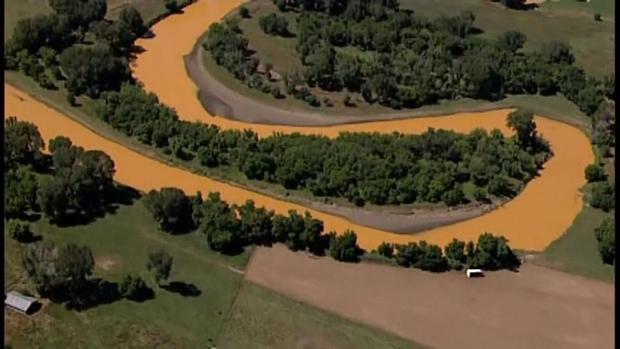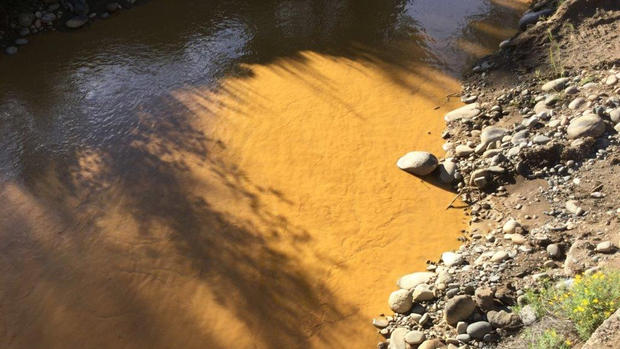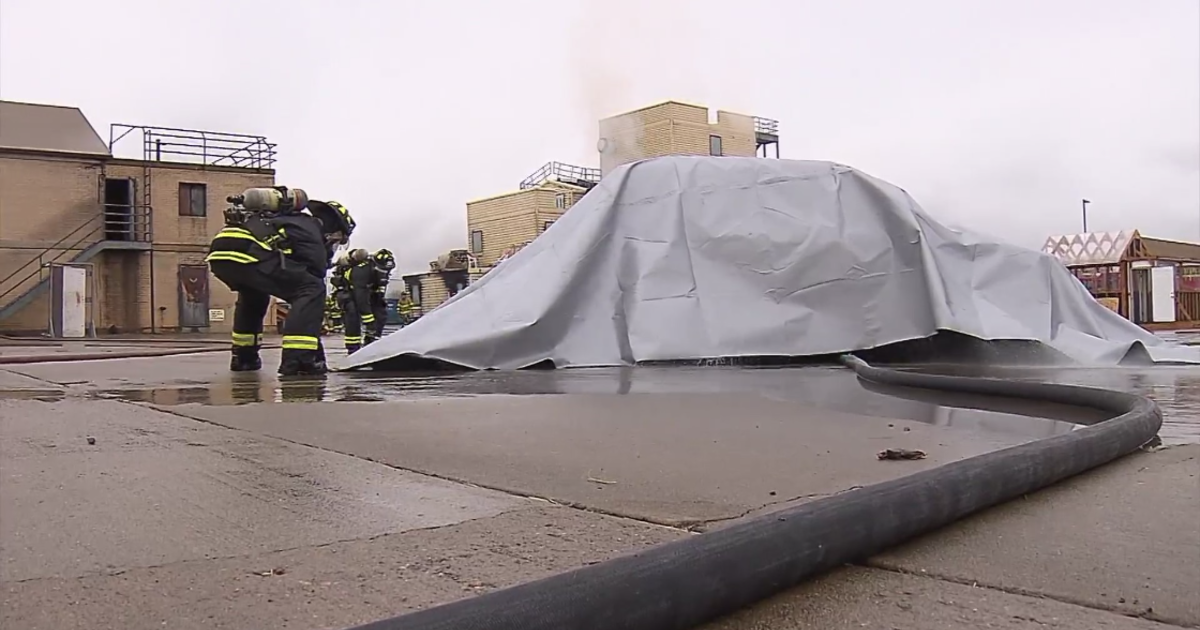Wednesday's Mine Spill Timeline: EPA Head To Visit New Mexico To Address Spill
DURANGO, Colo. (AP) - The latest in the Colorado mine spill:
5:40 p.m.
The head of the Environmental Protection Agency says she will visit the small community of Farmington, New Mexico, downstream from where millions of gallons of mine waste spilled into a southwest Colorado river.
EPA Administrator Gina McCarthy is scheduled to address the agency's response in Farmington on Thursday. On Wednesday, she spoke with residents of Durango, Colorado, as well as state, local and tribal officials.
An EPA-supervised cleanup crew accidentally unleashed 3 million gallons of wastewater from an old mine that flowed into southwest Colorado's Animas River.
McCarthy said Wednesday that "no agency could be more upset about the incident happening, and more dedicated in doing our job to get this right. We couldn't be more sorry."
5:25 p.m.
A Colorado-based Bureau of Reclamation spokeswoman says the agency isn't currently concerned with the water quality at Lake Powell or downstream.
Justyn Liff says the heavy-metal laced wastewater spill is the size of 4 1/2 Olympic-size swimming pools, while Lake Powell contains enough water to fill about 6.4 million similar pools.
National Parks officials said the spill hadn't reached the reservoir by Wednesday. Liff says her agency is monitoring the water quality, but "right now we don't have any cause for concern."
5:15 p.m.
U.S. House Speaker John Boehner says the Colorado mine wastewater spill is serious and so is the EPA's slow response.
The Ohio Republican called on the Obama administration Wednesday to do everything in its power to protect people in the affected states of Colorado, New Mexico and Utah.
Boehner said in a statement Wednesday that the House will monitor the Environmental Protection Agency's damage assessments, cleanup efforts and its response to the concerns of affected Native American tribes.
An EPA-supervised cleanup crew accidentally unleashed 3 million gallons of wastewater from an old mine that flowed into southwest Colorado's Animas River.
The EPA has been criticized by local officials for delayed notifications about the spill and for not saying when it will release its own water-testing results a week after the spill.
4:45 p.m.
Utah Gov. Gary Herbert has declared an emergency for parts of the state affected by mine wastewater from Colorado.
Herbert says the designation will help free up public money to help people and businesses in southern Utah who depend on water from the San Juan River deal with the long-term effects of contamination from the spill.
Governors in New Mexico and Colorado, as well as the Navajo Nation, have made similar declarations.
Utah officials said Wednesday that weekend tests showed the presence of metals in the state's river water, but the plume has since assimilated into the river water and lost its distinctive yellow color.
4:33 p.m.
The top prosecutors from three Western states say it's too early to say whether they'll pursue legal action against the federal government for a massive spill at a Colorado mine that polluted two rivers in the Four Corners region.
Colorado Attorney General Cynthia Coffman said during a news conference Wednesday that the U.S. Environmental Protection Agency deserves a chance to prove it will be accountable for the Aug. 5 spill caused by one of its crews.
Still, she and the attorneys general from New Mexico and Utah say they stand ready to protect the rights of their states' residents and ensure they are compensated for immediate and long-term damage caused by the spill.
Coffman acknowledged that it could be years before the effects are known.
New Mexico Attorney General Hector Balderas says he and his counterparts will be monitoring the claims process to ensure federal funds get to the areas that have been affected.
4:09 p.m.
Colorado health officials say the city of Durango can resume using drinking water treatment facilities that draw from the river affected by a mine spill.
The Colorado Department of Health and Environment made the announcement Wednesday, one week after an EPA-supervised crew accidentally unleashed 3 million gallons of wastewater from an old mine that flowed into the Animas River.
Water treatment facilities in Durango stopped using water from the river after the spill, which contains heavy metals including arsenic and lead.
Dr. Larry Wolk, the state's chief medical officer, says his department will keep monitoring water sample testing. He says technicians will be sent to test water from private drinking wells within a mile of the river, although there's no indication that the private wells were contaminated.
3:39 p.m.
The head of the Environmental Protection Agency has ordered agency offices nationwide to stop field investigation work for mine cleanups while they reassess the work to ensure there's no potential for spills similar to the one in Colorado.
EPA Administrator Gina McCarthy announced the change Wednesday on a visit to Durango, but it's not clear whether the stoppage applies to cleanups already underway or how many projects would be affected.
It came a week after an EPA-supervised crew accidentally unleashed 3 million gallons of wastewater from an old mine that flowed into the Animas River.
McCarthy says the latest water testing results show that the river in Durango has returned to its former condition. She didn't release further details.
That announcement could signal an end to a dispute between the agency and Colorado, which wants to reopen the river to boating and fishing, key parts of the area's tourism economy.
2:35 p.m.
New Mexico's attorney general says communities affected contaminated wastewater that spilled from a Colorado mine have anywhere from seven to 50 days of drinking water in storage tanks and reservoirs.
Hector Balderas says the towns are anxious for the release of sampling results from the Animas and San Juan rivers. He spoke Wednesday after meeting with local officials in Farmington, New Mexico. He was headed to Durango, Colorado, to meet with his counterparts from that state and Utah.
Communities in northwestern New Mexico and on the Navajo Reservation have made plans to access other sources of water, but Balderas said his office is among those pressuring federal officials to get better data and release it in a timely manner.
Balderas says that because there are questions about the safety of the river, it's too early to guess at the true costs of what he called an unfortunate disaster.
2:07 p.m.
Federal officials say 3 million gallons of waste that spilled from an old Colorado mine hasn't arrived at Lake Powell yet, but it will be further diluted in the massive body of water when it does.
The Bureau of Reclamation says the reservoir on the Utah-Arizona border holds about 4.2 trillion gallons of water, dwarfing the spill.
The breach last week sent a plume of metal-laden water coursing into the Animas and San Juan rivers. At Lake Powell, the San Juan meets the Colorado River, which provides water to parts of California, Arizona, Nevada, New Mexico and Utah.
Contaminants settling into sediment could end up at the deltas of the rivers as they empty into Lake Powell and be stirred up again as water levels rise or during flooding.
Katie Wood, a spokeswoman for Glen Canyon National Recreation Area, says it's a possibility officials will monitor.
12:40 p.m.
Colorado wildlife officials will test more than 100 fish caught along the Animas River at the height of a mine waste spill that turned the water orangey-yellow.

Parks and Wildlife spokesman Matt Robbins said Wednesday that biologists in Denver will determine whether the spill's heavy metals accumulated in the fingerling trout. Results won't be known for at least two weeks.

The breach last week sent a plume of metal-laden water coursing into the Animas and San Juan rivers. The pollution has passed through parts of Colorado, New Mexico, Utah and the Navajo Nation.
Of the 108 fish placed in underwater cages during the worst of the spill, only one died. It's unknown whether the death stemmed from pollution or other reasons.
The agency also plans a survey of wild fish in the Animas and will compare it to a survey done last year.
11:03 a.m.
Colorado and federal officials are at odds over whether it's safe to reopen the Animas River to recreation after 3 million gallons of mine waste spilled and turned the water orangey-yellow.
The shocking color seen last week is gone, and Colorado says its tests show the concentration of metals in the water, including arsenic and lead, are decreasing. Gov. John Hickenlooper wants the river reopened to boating and fishing, both important to the region's economy.
The Durango Herald newspaper reports that local EPA administrator Shaun McGrath told Hickenlooper during a meeting to stop making comments about the health of the river.
McGrath says more data are needed to know whether the river is back to baseline conditions. That angered Hickenlooper, who, echoing others, said the EPA has been too slow in responding to the disaster overall.
10:12 a.m.
New Mexico Gov. Susana Martinez says she still has concerns about the federal government's response to the spill of millions of gallons of wastewater from a mine in southwestern Colorado.
The breach last week at the Gold King Mine near Silverton sent a flood of yellow, metal-laden water coursing into the Animas and San Juan rivers. The plume has since passed through parts of Colorado, New Mexico, Utah and the Navajo Nation.
Martinez says EPA Administrator Gina McCarthy's visit Wednesday will be important, so McCarthy can see firsthand the potentially devastating effects the spill can have on downstream communities.
Martinez's office says the governor spoke with McCarthy on Tuesday evening.
RELATED: Everything You Need To Know About The Animas River Spill
The New Mexico Environment Department has been conducting its own sampling along the river and results are expected Wednesday.
9:58 a.m.
The head of the Environmental Protection Agency will meet with state, local and tribal officials and community members when she visits Colorado on Wednesday to see the impact of a 3 million-gallon mine waste spill.
EPA Administrator Gina McCarthy also plans to visit Farmington, New Mexico, on Thursday.
She says the agency takes full responsibility after an EPA-led crew accidentally released the wastewater laced with heavy metals, including lead and arsenic.
PHOTO GALLERY: Gov. Hickenlooper Tours Animas River
The pollution turned part of the Animas River in Colorado mustardy yellow last week. It washed down the river and is believed to have passed into Utah, but it's difficult to detect because it's been diluted.
The EPA has said the flows are moving too fast for the contaminants to pose an immediate health threat and that the heavy metals will likely be diluted over time so they don't pose a longer-term threat.
However, local and tribal officials are concerned about river sediment being contaminated and the potential long-term effects.
7:35 a.m.
The head of the Environmental Protection Agency plans to visit Colorado and New Mexico sometime Wednesday to see the impact of a 3 million gallon mine waste spill triggered during an agency-led cleanup.
EPA Administrator Gina McCarthy says the spill that turned part of the Animas River in Colorado a shade of mustardy yellow last week "pains me to no end" and her department takes full responsibility.
The pollution washed down the river and is believed to have passed into Utah but it's difficult to detect because it has been diluted and no longer has the bright color.
The EPA has said the current flows are too fast for the contaminants to pose an immediate health threat, and that the heavy metals will likely be diluted over time so they don't pose a longer-term threat, either.
(© Copyright 2015 The Associated Press. All Rights Reserved. This material may not be published, broadcast, rewritten or redistributed.)







